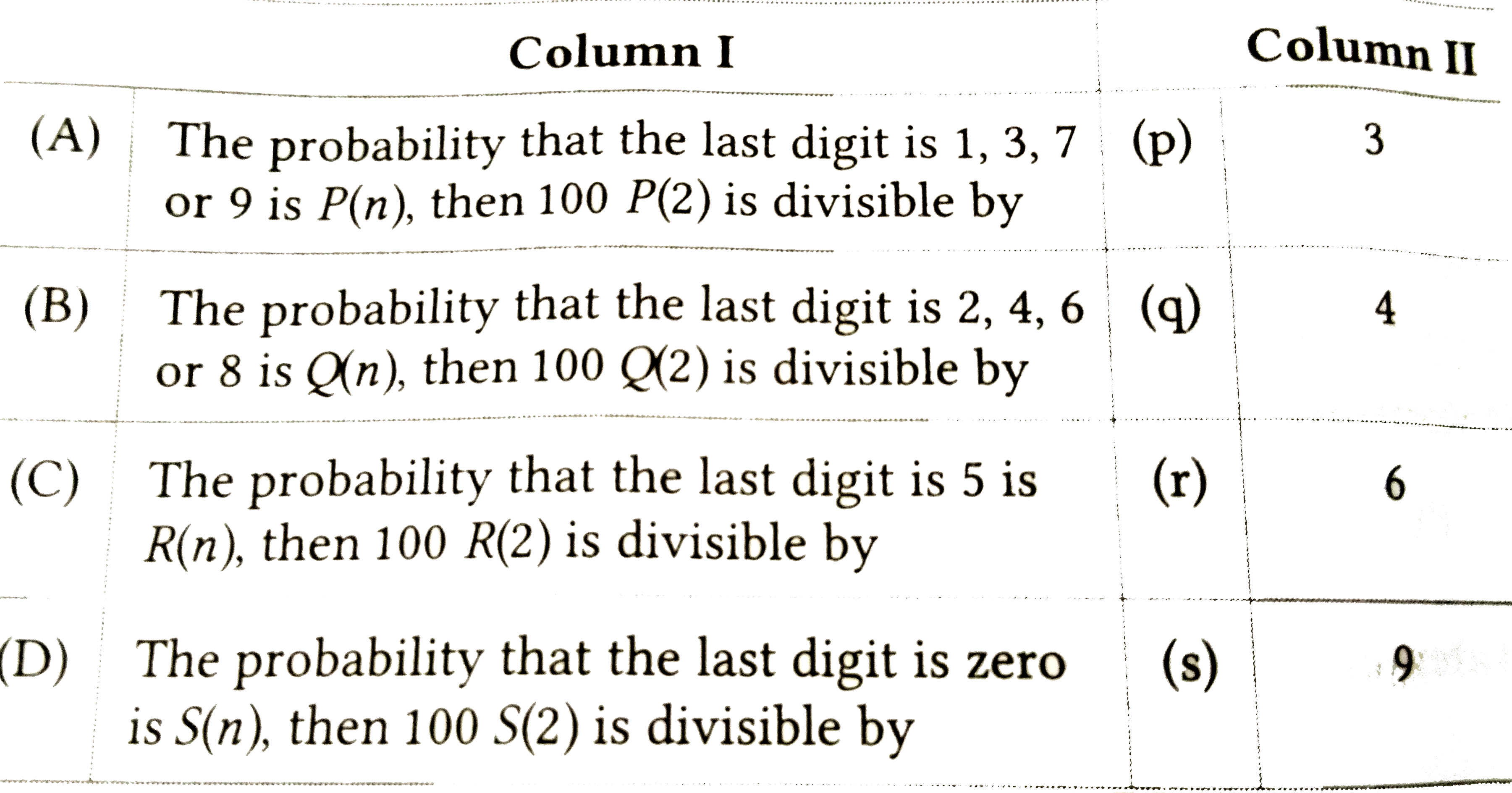If n integers taken at random are multiplied together , then the probability that the last digit of the product is 1, 3, 7, or 9 is a. 2n/5n b. 4n−2n/5n c. 4n/5n d. none of these
To solve the problem of finding the probability that the last digit of the product of n randomly chosen integers is 1, 3, 7, or 9, we can follow these steps:
Step 1: Identify the total possible last digits
The last digit of any integer can be one of the following 10 digits: 0, 1, 2, 3, 4, 5, 6, 7, 8, 9. Therefore, there are a total of 10 possible outcomes for the last digit.
Hint: Consider all the digits from 0 to 9 when determining the total outcomes.
Step 2: Identify the favorable outcomes
We are interested in the last digits that are either 1, 3, 7, or 9. This gives us 4 favorable outcomes.
Hint: Count how many digits from the total set meet the condition of being 1, 3, 7, or 9.
Step 3: Calculate the total outcomes for n integers
When we choose n integers, each integer can have any of the 10 last digits. Thus, the total number of combinations for the last digits of n integers is \(10^n\).
Hint: Think about how many choices you have for each integer and multiply them together.
Step 4: Calculate the favorable outcomes for n integers
For each of the n integers, we have 4 choices (1, 3, 7, or 9) for the last digit. Therefore, the total number of favorable outcomes for the last digits of n integers is \(4^n\).
Hint: Similar to the total outcomes, consider how many choices you have for each integer when calculating favorable outcomes.
Step 5: Calculate the probability
The probability \(P\) that the last digit of the product of the n integers is one of the favorable outcomes (1, 3, 7, or 9) can be calculated using the formula:
\(
P = \frac{\text{Number of favorable outcomes}}{\text{Total outcomes}} = \frac{4^n}{10^n}
\)
Step 6: Simplify the probability
Now, we can simplify the probability:
\(
P = \frac{4^n}{10^n} = \frac{4^n}{(2 \cdot 5)^n} = \frac{4^n}{2^n \cdot 5^n} = \frac{2^n}{5^n}
\)
Thus, the final answer is:
\(
P = \frac{2^n}{5^n}
\)
Conclusion
The correct option is (a) \(\frac{2^n}{5^n}\).
---
The last digit of any integer can be one of the following 10 digits: 0, 1, 2, 3, 4, 5, 6, 7, 8, 9. Therefore, there are a total of 10 possible outcomes for the last digit.
We are interested in the last digits that are either 1, 3, 7, or 9. This gives us 4 favorable outcomes.
When we choose n integers, each integer can have any of the 10 last digits. Thus, the total number of combinations for the last digits of n integers is \(10^n\).
For each of the n integers, we have 4 choices (1, 3, 7, or 9) for the last digit. Therefore, the total number of favorable outcomes for the last digits of n integers is \(4^n\).
The probability \(P\) that the last digit of the product of the n integers is one of the favorable outcomes (1, 3, 7, or 9) can be calculated using the formula:
P = \frac{\text{Number of favorable outcomes}}{\text{Total outcomes}} = \frac{4^n}{10^n}
\)
Now, we can simplify the probability:
P = \frac{4^n}{10^n} = \frac{4^n}{(2 \cdot 5)^n} = \frac{4^n}{2^n \cdot 5^n} = \frac{2^n}{5^n}
\)
P = \frac{2^n}{5^n}
\)
The correct option is (a) \(\frac{2^n}{5^n}\).
Similar Questions
If n positive integers are taken at random and multiplied together, then the probability that the last digit of the product is 2,4,6 or 8, is
View SolutionIf n positive integers taken at random are multiplied together.

View SolutionIf 5 positive integers are taken at random and multiplied together. The probability that the last digit of the product is 2,4,6,8 is
View SolutionA 2n digit number starts with 2 and all its digits are prime, then the probability that the sum of all 2 consecutive digits of the number is prime is a.4×23n b. 4×2−3n c. 23n d. none of these
View Solutionn whole are randomly chosen and multiplied
Column I, Column II
The probability that the last digit is 1,3,7, or 9 is, p. 8n−4n10n
The probability that the last digit is 2,4,6, or 8 is, q. 5n−4n10n
The probability that the last digit is 5 is, r. 4n10n
The probability that the last digit is zero is, s. 10n−8n−5n+4n10n
View SolutionThe nth term of the sequence 5+55+555+... is
a.5×10n−1 b. 5×11n−1 c. 59(10n−1) d. none of these
View SolutionSuppose n(≥3) persons are sitting in a row. Two of them are selected at random. The probability that they are not together is (A) 1−2n (B) 2n−1 (C) 1−1n (D) nonoe of these
View SolutionIn a sequence of (4n+1) terms, the first (2n+1) terms are n A.P. whose common difference is 2, and the last (2n+1) terms are in G.P. whose common ratio is 0.5 if the middle terms of the A.P. and LG.P. are equal ,then the middle terms of the sequence is n.2n+122n−1 b. n.2n+12n−1 c. n.2n d. none of these
View SolutionIf n is a one-digit positive integer, what is n?
(1) The units digit of 4n is 4.
(2) The units digits of n4 is n.
View SolutionIf in the expansion of (a−2b)n, the sum of 5th and 6th terms is 0, then the values of ab a. n−45 b. 2(n−4)5 c. 5n−4 d. 52(n−4)
View Solution
